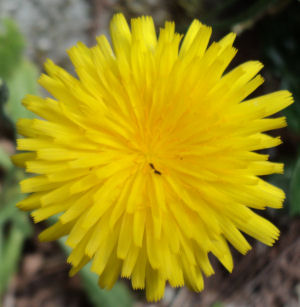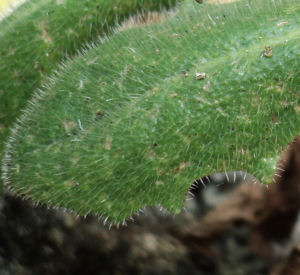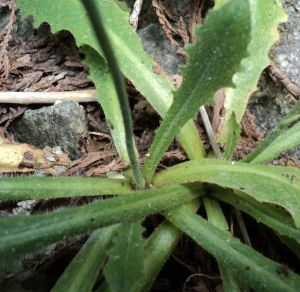|
|
|
|
|
|
| Practical ecological knowledge for the temperate reader. |
Hypochaeris Sp. - Cat's-ear
- Family: Asteraceae - Aster
[E-flora]

Hypochoeris radicata |

Hypochoeris radicata |

Hypochoeris radicata |
"Annual, perennial herb; sap milky. Stem: erect, 1–8 dm, simple or few-branched. Leaf: basal in rosette, oblanceolate, margin entire to pinnately lobed; cauline alternate, scale-like. Inflorescence: heads liguliflorous, 1–few, erect, terminal on stem, branches; involucre cylindric to bell-shaped in flower, elongating in fruit; phyllaries graduated in 4–5 series, reflexed when dry; receptacle flat to convex, paleate with thin membranous scales, glabrous. Flower: generally many; ligules yellow, often ± red abaxially, readily withering. Fruit: fusiform, ribbed, long-beaked, or outer cylindric, beakless; pappus of stiff, plumose bristles, or shorter outer bristles merely barbed, tawny or dull white."
"± 60 species: Eurasia, northern Africa, South America. (Greek: less than joyous, from weedy habit) [Bogler 2006 FNANM 19:297–299]"
"Unabridged note: Etymology differs from that in FNANM, where the etymology on the Greek 'choeris' for pig; the correct spelling is 'chaeris' for joy." [Jepson]
Local Species;
- Hypochaeris glabra - Smooth Cat's-ear [E-flora][PCBC][TSFTK]
- Hypochaeris radicata - Hairy Cat's-ear [E-flora][PCBC][TSFTK]
Hypochaeris glabra - Smooth's Cat's-Ear
Synonym:
- Hypochoeris glabra. [PFAF]
Hypochoeris glabra is a ANNUAL/PERENNIAL growing to 0.3 m (1ft).
It is not frost tender. It is in flower from Jun to October. The flowers are hermaphrodite (have both male and female organs) and are pollinated by Bees, flies. [PFAF]
Suitable for: light (sandy) and medium (loamy) soils and prefers well-drained soil. Suitable pH: acid and neutral soils. It cannot grow in the shade. It prefers dry or moist soil.[PFAF]
- Origin Status: Exotic. [E-flora]
- General: Annual herb from a taproot; stems erect, solitary or more often several, simple or sparingly branched, minutely bristly or glabrous, exuding milky juice when broken, 10-40 cm tall. [IFBC-E-flora]
- Leaves: Basal leaves well-developed, oblanceolate, entire or lobed, glabrous to fringed on the margins, 2.5-15 cm long and 7-35 mm wide; stem leaves lacking or if present then minute and bractlike. [IFBC-E-flora]
- Flowers: Heads with strap-shaped flowers, solitary to many in a terminal, flat-topped inflorescence; involucres 8-10 mm tall, 0.5-1.5 cm wide, increasing to 17 mm tall in fruit; involucral bracts spirally arranged, lanceolate, glabrous; ray flowers yellow. [IFBC-E-flora]
- Fruits: Achenes nerved with minute projections, 4-5 mm long, inner ones with a well-developed beak as long as the body; pappus double, the inner ones of feathery bristles, the outer ones shorter and usually merely finely-barbed. [IFBC-E-flora]
- Habitat / Range Roadsides, pastures and waste areas in the lowland zone; frequent in SW BC, known from S Vancouver Island and the Gulf Islands; introduced from Europe.[IFBC-E-flora]
Grassy fields, derelict arable land, heaths, fixed dunes etc on sandy soils. This is a typical plant of non-calcareous sand plant communities[17]. Europe, including Britain, from Scandanavia south and east to N. Africa, Syria and W. Asia. [PFAF]
Hypochoeris radicata - Hairy Cat's-Ear
"Hypochoeris radicata is a PERENNIAL growing to 0.3 m (1ft)."
"It is hardy to zone (UK) 5 and is not frost tender. It is in flower from Jun to September, and the seeds ripen from Jul to September. The flowers are hermaphrodite (have both male and female organs) and are pollinated by Bees, flies lepidoptera." [PFAF-2] "Suitable for: light (sandy), medium (loamy) and heavy (clay) soils. Suitable pH: acid, neutral and basic (alkaline) soils. It cannot grow in the shade. It prefers dry or moist soil." [PFAF-2]
- General: "Perennial herb from a woody stem-base or enlarged fibrous root; stems erect, simple or more often branched, several, often spreading-hairy below, exuding milky juice when broken, 15-60 cm tall." [IFBC-E-flora-2]
- Leaves: "Basal leaves oblanceolate, densely stiff-hairy, toothed or pinnately cut, 3-35 cm long, 5-70 mm wide; stem leaves mostly lacking, represented by minute bracts." [IFBC-E-flora-2]
- Flowers: "Heads with strap-shaped flowers, several in a terminal, flat-topped inflorescence; involucres 10-15 mm tall, at flowering, up to 25 mm in fruit, 2-4 cm wide; involucral bracts graduated, bristly-hairy or glabrous; ray flowers yellow." [IFBC-E-flora-2]
- Fruits: "Achenes nerved on the beak with minute projections, 4-7 mm long, inner ones with a well-developed beak shorter or longer than the body; pappus double, the inner ones of feathery bristles, the outer ones shorter and usually merely finely-barbed." [IFBC-E-flora-2]
Origin Status: Exotic. [E-flora-2]
Ecological Indicator Information: "A very shade-intolerant, submontane to montane, European forb introduced to Pacific, Cordilleran, and Atlantic North America. Inhabits exposed mineral soil on watershedding sites within montane boreal, temperate, and cool mesothermal climates; its occurrence decreases with elevation and latitude. Common in early-seral (often meadow-like) communities. Characteristic of disturbed sites." [IPBC-E-flora-2]
Habitat / Range: "Mesic to dry roadsides, lawns, pastures and waste places in the steppe and lowland zones; common in SW BC, known from Vancouver Island and the Gulf Islands, also on the Queen Charlotte Islands, rare in SC BC; introduced from Europe." [IFBC-E-flora-2]
"Meadows and dry pastures, grassy dunes, waysides and open woods[5, 17]. Europe, including Britain, from Scandanavia south and east to N. Africa and western Asia." [PFAF-2]
Hazards
Stringhalt: S. radicata; "This species is suspected of causing Stringhalt in horses if consumed in excess.(1,2)." "The most common plant species that have been found and identified in pastures where affected horses were located include: flatweed (Hypochaeris radicata), sheep's sorrel (Rumex acetosella) and couch grass (Elymus repens). The type of nerve damage sustained in horses with Australian stringhalt suggests a mould toxin (mycotoxin) or a fungal 'poison' found in the soils may be a cause for this condition. Mycotoxins can directly affect the long myelinated nerves in the hind limbs.[3]" [Wiki]1
"Hypochaeris radicata causes stringhalt (high stepping with hyperflexion of the hind
limb) in horses in different countries." [Riet-Correa PPMRT]
"The disease named Australian stringhalt is different from classical stringhalt. The
disease caused by H. radicata is more severe, usually bilateral, occurs in outbreaks, is
seasonal, and most animals recover spontaneously. Classical stringhalt is a sporadic disease
of unknown cause that has to be treated surgically because there is no spontaneous recovery
(Rodrigues et al. 2007; Araújo et al. 2008)." [Riet-Correa PPMRT]
"The disease was reproduced experimentally in a 6-month-old horse weighing 250 kg
by the daily administration of 9.8 kg of fresh plant for 50 days. Clinical signs first appeared
19 days after dosing began (Araújo et al. 2008)." [Riet-Correa PPMRT]
"Treatment with phenytoin or other anticonvulsants can be of benefit. Grazing should
be avoided in areas severely infested by the plant in order to prevent the disease." [Riet-Correa PPMRT]
Edible Uses
- Plant:
- Hypochaeris spp. (H. radicata, H. maculata) (common cat’s ear); Asteraceae—boiled leaves; plant included in the “preboggion” and “pistic” blends. [ETWP]
- H. radicata; "All parts of the catsear plant are edible; however, the leaves and roots are those most often harvested. The leaves are bland in taste but can be eaten raw in salads, steamed, or used in stir-fries. Older leaves can become tough and fibrous, but younger leaves are suitable for consumption. In contrast to the edible leaves of dandelion, catsear leaves only rarely have some bitterness. In Crete, Greece, the leaves of a variety called παχιές (pachiés) or αγριοράδικα (agriorádika) are eaten boiled or steamed by the locals.[13]" [Wiki-2]
- Young Leaves:
- H. glabra; Raw or cooked.[144] Somewhat bitter, they are used as an emergency food.[177] [PFAF]
- H. radicata; "Young leaves - raw or cooked like spinach[5, 52, 53, 183]. A winter salad[100], it is rather bitter[K]. Young leaves are mild and agreeable[217]." [PFAF] leaf - Boiled and eaten. [ETWP] Dried greens contain 9.4g protein and 20.9g ash per 100g. [Turner&Kuhnlein]
- Root:
- H. radicata; "The root can be roasted and ground to form a coffee substitute." [Wiki-2]
Other Uses
- Fodder:
- Hypochaeris Sp. - Relished by goats. Especially the stems. [Lans et al., 2007]
Medicinal Uses
- Unspecified Part:
- H. radicata; Pectoral[100]. [PFAF-2]
Pharmacology
- H. glabra;
- Root - Aperient, diuretic and tonic.[240] [PFAF]
- Leaves - Astringent.[240] [PFAF]
- Whole Plant - Vulnerary.[240] [PFAF]
Phytochemicals
- H. glabra: Pseudo-disesquiterpenoid DSs
- 8a-Hypoglabroyloxy-jaquinelin [Kinghorn PCNP101]
- Lactucin-8-O-hypoglabrate [Kinghorn PCNP101]
Cultivation
- H. glabra; Requires a light to medium well-drained soil in a sunny position. [PFAF]
- H. radicata; Requires a well-drained soil and a sunny position or light shade. Another report says that it dislikes shade. A common lawn weed[24].[PFAF-2] "herbaceous species such as hairy cats-ear (Hypochaeris radicata) can be found along many backroads in mature conifer forests. These can readily invade restoration sites and, absent a well-developed strategy for addressing these species, can derail or at least delay restoration." [Apostol RPNW]
Propagation
H. glabra; Seed - sow spring in a cold frame and only just cover the seed. When they are large enough to handle, prick the seedlings out into individual pots and plant them out in the summer. If you have enough seed it can be sown outdoors in situ in the spring. [PFAF]
H. radicata; Seed - sow spring in a cold frame and only just cover the seed. When they are large enough to handle, prick the seedlings out into individual pots and plant them out in the summer. If you have sufficient seed it can be sown outdoors in situ in the spring.[PFAF-2]
Related sp.
Hypochaeris maculata Linnaeus
spotted cat’s-ear
northern and central Europe
In one district in theYorkshire Pennines in the eighteenth century,Hypochaeris
maculata was believed a cure for‘tetters’and other skin complaints—because
of its spotted leaves, it has been (perhaps fancifully) suggested.70 [MPFT]
|
Paramo chicory (hypochaeris sessiliflora Kunth) "Paramo species from Venezuela to Bolivia, reported ethnobotanically from Peru (EGG) but not taxonomically reconfirmed (BAZ)." [Duke MPLA]
|
|
Activities:
- Antibilious (f; DLZ; EGG);
- Antimalarial (f; DLZ);
- Depurative (f; MPG);
- Laxative (f; MPG);
- Purgative (f; MPG);
- Refrigerant (f; MPG);
- Sudorific (f; MPG).[Duke MPLA]
|
Indications:
- Biliousness (f; DLZ; EGG);
- Constipation (f; MPG);
- Fever (f; MPG);
- Hepatosis (f; EGG);
- Malaria (f; DLZ; MPG).[Duke MPLA]
|
- Venezuelans eat leaves in salads, like chicory. Bolivians chew the latex like chewing gum (DLZ; MPG)
- Bolivians regard the decoction as antibilious and antimalarial (DLZ).
- Peruvians use the plant as antibilious in liver problems (EGG).
- Venezuelans use the plant as depurative, laxative, purgative, refrigerant, sudorific, and for malaria (MPG).[Duke MPLA]
|
Hypoclulerin - Hypochaeris setosus [Connolly DT]
References
- [E-flora]
- [1]Hypochaeris glabra, http://linnet.geog.ubc.ca/Atlas/Atlas.aspx?sciname=Hypochaeris glabra&redblue=Both&lifeform=7, Klinkenberg, Brian. (Editor) 2013. E-Flora BC: Electronic Atlas of the Flora of British Columbia (eflora.bc.ca). Lab for Advanced Spatial Analysis, Department of Geography, University of British Columbia, Vancouver.[Accessed: 7/18/2014]
- [2]Hypochaeris radicata, http://linnet.geog.ubc.ca/Atlas/Atlas.aspx?sciname=Hypochaeris radicata&redblue=Both&lifeform=7, In Klinkenberg, Brian. (Editor) 2013. E-Flora BC: Electronic Atlas of the Plants of British Columbia [eflora.bc.ca]. Lab for Advanced Spatial Analysis, Department of Geography, University of British Columbia, Vancouver. [Accessed: 7/18/2014]
- [freitas,2004] - Analysis of serpentinophytes from north–east of Portugal for trace metal accumulation––relevance to the management of mine environment, H. Freitas, M.N.V. Prasad, J. Pratas, Chemosphere 54 (2004) 1625–1642
- [Lans et al., 2007] - Ethnoveterinary medicines used for ruminants in British Columbia, Canada, Cheryl Lans, Nancy Turner, Tonya Khan, Gerhard Brauer and Willi Boepple, Journal of Ethnobiology and Ethnomedicine 2007, 3:11 doi:10.1186/1746-4269-3-11
- [Jepson]Kenton L. Chambers, 2013. Hypochaeris, in Jepson Flora Project (eds.) Jepson eFlora, http://ucjeps.berkeley.edu/cgi-bin/get_IJM.pl?tid=3625, accessed on Jan 3 2015
- [PFAF]
- [Wiki] Wikipedia.org
- [1]https://en.wikipedia.org/wiki/Stringhalt, Accessed October 22, 2017
- (1) John Kohnke. "Australian stringhalt". South East Victoria Equine Network.
- (2) Stringhalt - The Merck Veterinary Manual, 9th Edition, http://merckvetmanual.com
- (3) [Huntington, P.J., Jeffcott, L.B., Friend, S.C.E., Luff, A.R., Finkelstein, D.I. & Flynn R.J. (1989) Australian String halt - epidemiological, clinical and neurological investigations. Equine Veterinary Journal, 21, 266-273.]
- [2]https://en.wikipedia.org/wiki/Hypochaeris_radicata, Accessed November 27, 2016
- (13)Kleonikos G. Stavridakis , Κλεόνικος Γ. Σταυριδάκης (2006). Wild edible plants of Crete - Η Άγρια βρώσιμη χλωρίδα της Κρήτης. Rethymnon Crete. ISBN 960-631-179-1.
Page last modified on Thursday, July 6, 2023 10:53 AM